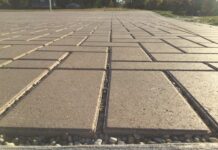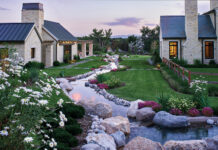Can a historic home and a brand-new pond/waterfall exist in perfect harmony? For designer Stephanie Scott and the crew at Yards Unlimited Landscaping, there was never a doubt.
In the end, not only were the clients pleased, but the project was also recognized by the Landscape Ontario Horticultural Trades Association with one of its annual awards for water features.
Scott explains that she met the homeowners at a home show in Ottawa. They had recently purchased the stone residence, which was built in 1828 and listed as one of the Canadian capital’s designated heritage buildings, and wanted to incorporate water into the landscape.

She adds that one of the clients had grown up with a small bubbling rock in the family’s backyard, and the home the couple was leaving had had a backyard pond they had built themselves.
“It was important that this new water feature blend in with the feel and age of the house,” Scott says. “I explained then that when creating a water feature, everything is in the details, from the layout to the choice of stone to the plant material.”
However, the property is certainly not the typical flat suburban lot. The home had been built into a hillside, and the lot itself wasn’t particularly wide, although fairly deep. And, while the backyard is large, it presented its own challenge: the grassy expanse serves as the septic field.

Scott, however, didn’t see that as a drawback. She opted to place the water feature at the side of the house, instead.
“We wanted to make good use of that natural sloping grass on the side,” she says. “It’s much easier to create a water feature that looks natural when you have a slope to work with as opposed to trying to create an elevation.”
Even when confident of her site, however, Scott says there were challenges. High on the list was access to the construction site, which offered narrow side setbacks and woods at the rear. As a result, the crew had to temporarily remove part of an original stone wall, as well as protect the roots of a 300-year-old oak.
“It was important to keep the feel of the property and to imagine what a waterfall and pond would have looked like if it had been there for years,” says Scott. “That’s what I tried to create here, even with the plant choices, using some native plant material and grasses.”

One key feature, although not one she lists as a challenge, was the clients’ requirement that the pond be large enough to support a dozen koi.
“We certainly had to take that into account,” Scott says. “And, because of our winters here, ponds have to be a certain depth to allow those fish to survive. Not only did we have to go deeper but I had to calculate the amount of water required to support 12 mature koi.”
While koi tend to go into a state of torpor once the air temperature cools below 50 degrees Fahrenheit, Scott says the clients do keep the pond aerated over the winter.
Creating the waterfall and pond required a substantial use of natural stone, which Yards Unlimited obtained from a local distributor.

“The clients came with me and we selected weathered stone,” Scott says. “We selected some very specific stones and wanted large ones that looked like they had always been on the property. We took quite a bit of time selecting them.”
All the stone is naturally set. Scott says the largest ones were set first to help create the stream and then the smaller ones were placed around those.
“It was important to get the water to change directions where it hit the big rocks as it would in nature,” she says. “We took the time to create a natural-looking stream. The falls also split in some areas which adds a lot of interest from various vantage points.”
Again, she notes that the largest stones had to be ferried individually to the construction site.
Flagstone is utilized in the area around the pond, and even in the pond itself, since part of its construction includes a flagstone shelf at the bottom to give the fish a place to hide from large water birds that inhabit the area.

One of the clients’ goals was having a place where their nieces and nephews could come and enjoy feeding the fish. However, Scott also paid attention to wildlife that might be in the area.
“I made sure there was a safe place for them to enjoy the pond by adding a large flagstone feeding area overhanging the pond,” she says. “The pebble beach is a wonderful feature that was intended to provide an escape for any trapped wildlife, but it’s brought so much more to the pond. Birds come to bathe in the evening and frogs are able to come and go as they please.”
Planting around the water feature also kept the non-human habitants of the area in mind. Scott explains that some plants were interwoven into the areas of smaller stones to create a natural-looking element.
Native plants include nodding onion, Bebb’s sedge and bristle leaf sedge, while the non-native plant list features geranium rozanne (which blooms from May to October in Ottawa), white coneflower, rosy return daylily, Bobo hydrangea and lavender elegance purple.
“The tall grasses frame the medium and smaller plants to create visual interest,” Scott says. “By including a lot of native plants, especially on the side close to the water, it encourages the native insects and frogs, as well as other wildlife. And, there’s always something new and exciting to see, whether it’s a new flower or a bee gathering pollen.”

Scott credits much of the success of the project — which cost approximately $40,000 — to the Yards Unlimited crew, which ranged from three to four men over the three weeks of construction.
“The foreman and his crew did a fabulous job of implementing my vision,” she says. “They’ve given the homeowners a beautiful water feature which will only get better with each year that goes by.”
In fact, she says if nothing else, this project taught her the importance of having a team that has the same shared vision, passion, patience and willingness to collaborate to make it come together.
It’s that execution, coupled with her design, of which she’s most proud.
“As soon as I stepped foot in the backyard, and heard the running water cascading down, I knew it was perfect,” Scott concludes. “Every time clients are happy at the end of a project it makes me smile. That’s what it’s all about.”











![[VIDEO] Dickies®: Discover Workwear That’s Anything But Uniform](https://turfmagazine.com/wp-content/uploads/2023/06/1647663814-4b1a2a7742790a9b1e97a3b963477850192e1d6a9dfba9b07214a77bae25d6e3-d-218x150.jpg)




























![[VIDEO] Dickies®: Discover Workwear That’s Anything But Uniform](https://turfmagazine.com/wp-content/uploads/2023/06/1647663814-4b1a2a7742790a9b1e97a3b963477850192e1d6a9dfba9b07214a77bae25d6e3-d-324x160.jpg)
The surest, yet most costly and tedious, strategy is to deplete the pond and repair the dam. At long last, the least complex yet certain approach to seal a flawed pond are utilization of liner as Pond Repair. Pondpro2000 is good enough.